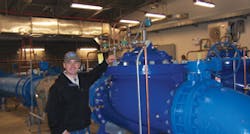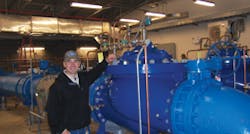Officials with the City of Bremerton, WA, knew that they had to make changes to the way their utility treated the 3.3 billion gallons of drinking water it supplies each year to its 55,000 customers. EPA was in the process of enacting tougher regulations on utilities such as Bremerton’s that rely on surface water for their supply of drinking water. Bremerton taps surface water from the nearby Union River Reservoir and groundwater from a series of production wells located across the Bremerton area for its water supply. EPA’s new rules require surface water systems to increase the frequency of their water monitoring and to use two distinct disinfectants to treat their drinking water. The goal of the new rule is to increase the detection of the microscopic organism Cryptosporidium, which can cause diarrhea. Bremerton’s utility has tested for this organism since 1994 and has never discovered it in its drinking water. But that didn’t mean that the utility didn’t have to boost its treatment and monitoring efforts to meet EPA’s new rule.
Like most utilities, Bremerton has long used chlorine as a way to treat its drinking water. Chlorine, though, is ineffective against Cryptosporidium. To meet EPA’s rules, Bremerton officials approved the construction of a new ultraviolet (UV) treatment facility, one that would use UV light to eliminate not only Cryptosporidium, but also a wide range of other contaminants in the city’s supply of drinking water. The new facility went online in 2011. And so far, says Kathleen Cahall, Water Resources Manager for the City of Bremerton, the facility has been operating exactly as it was advertised when officials with HDR Engineering brought the idea to them.
“This option made the most sense for us,” says Cahall. “It made the most sense both economically, and in terms of effectiveness. The more we found out about ultraviolet, the more we realized how effective it was. It treats for many other things. It was pretty amazing to learn what it can do.”
Bremerton, of course, is far from the only municipality taking a closer look at and changing the way it monitors, tests, and treats its drinking water. Increased regulation, as well as equally increased pressure from citizens, is forcing municipalities to turn to new techniques to assure that the drinking water they provide is free from contaminants.
These techniques include everything from ultraviolet rays to self-contained modular water-treatment systems that arrive at utilities pre-designed and pre-piped. Municipalities can also rely on specially designed filters designed to catch and remove arsenic and other contaminants from drinking water before they reach customers.
And the good news? Manufacturers working in the water treatment and testing industry say that municipal officials are more willing to try new techniques. And that’s something that bodes well for the future of this business.
“We have different technologies that we can provide municipalities that are interested in taking the steps necessary to improve their water quality,” says Eric Peterson, director of Municipal and Industrial Sales with Mooresville, NC-based Amiad USA. “And we’re seeing more municipalities looking for better ways to treat their water. That has certainly helped us. We have grown from a very small company into a prosperous mid-sized one today. We’re a company that can expect more than $100 million in sales during a given year now. And a lot of that is because you are seeing a greater on focus on water quality.”
More Awareness
Much of the growth experienced by Amiad and other water treatment companies can be traced to the increased focus many municipalities are placing on testing and treating their drinking water. This focus is a direct result of more stringent rules from EPA or from state and local governments. But much of it can also be traced to increased media attention received by municipalities when testing uncovers contaminants and other particles in drinking water.
No municipality wants to be on the receiving end of the bad publicity that comes with drinking water problems. To avoid this, many are boosting the dollars that they are spending on both testing and monitoring. And when municipalities take closer looks at their drinking water supply, it’s not unusual for them to find something that needs to be addressed.
“There is no doubt that more regulations are in place today than 15 years ago,” says Chad Miller, applications engineer with Buford, GA-based AdEdge Technologies, a firm that offers a range of water treatment technologies to municipalities. “People, communities, decision-makers are all testing more often, too. When you do testing, you often find what you are testing for.”
Miller points to a community in Georgia served by several new private wells that in the past were not required to be tested for traces of arsenic. Eventually, a government agency studied the new wells, taking water samples from them, and, to the surprise of many, they found arsenic.
“Believe it or not, that happens a lot,” says Miller. “Once you start looking for something, you’re often going to find it. Once you find it, people call up and ask, “˜What do we do about this?'”
Leo Zappa, a director in the municipal water market for Pittsburgh, PA-based Calgon Carbon Corporation–which supplies carbon and UV technology designed to remove contaminants from drinking water–says that improvements in technology are also fueling the increased focus on testing, monitoring, and treating. Water-testing equipment once was able to detect compounds in water on a parts-per-million basis. That has changed. Today, equipment can scan for particles on a parts-per-billion and parts-per-trillion basis, Zappa says. And if that’s not high-tech enough, the latest testing equipment can uncover particles on a parts-per-quadrillion basis, Zappa says.
The problem is, no one is yet sure if this is actually a good thing.
“The increasing precision and lowering of the detection threshold of testing equipment is driving increased public awareness, research efforts and regulatory efforts,” says Zappa. “This is because we can now find compounds in our water that we never knew were there before. This may be a mixed blessing for our society. It’s not clear that any of these compounds, at the minute levels detected, in fact pose any sort of health risk to humans or animals.”
Just the detection, though, of these minute compounds is enough to set municipalities into action. The reason? They don’t want to suffer the negative press–and perhaps legal action–that comes with delivering “contaminated” water, even if no one knows whether the “contaminants” are actually hurtful.
“Knowing these compounds are present in our water can drive a frenzy of activity, which can generate a whole host of new business opportunities for health researchers, environmental regulators, testing laboratories, consulting engineers and process equipment suppliers,” says Zappa.
“However, these business opportunities come at the price of driving up operating costs at water utilities and, by extension, drive up water bills for customers. The key is getting to the bottom of whether or not these compounds, at the levels at which they are present in our water supply, in fact pose a health risk.”
Like Zappa, Peachie Maher, market segment manager for Amiad, says that municipalities have always been focused on providing clean, safe drinking water to their residents. What has changed, though, is both the technology to detect organisms in the water supply and the media attention that results when anything unusual is found in drinking water.
“Before, people didn’t pay that much attention to their drinking water,” says Maher. “It came out of the faucet, and that was it. People didn’t think about how it came out of that faucet. There has certainly been a reaction on the part of municipalities because of the increased public scrutiny. Everyone today is trying to get ahead of things. They want to be more proactive.”
It’s easy to find examples today of community residents and media outlets responding aggressively to water-quality issues.
The Berkshire Eagle newspaper in Massachusetts in late January, for instance, wrote a story about the director of a private water lab being arraigned in Berkshire Superior Court on 30 charges of allegedly falsifying water-testing samples sent to EPA. Earlier in January, the Akron Beacon Journal in Ohio reported on Portage County, OH, citizens who were testing their own drinking water because they worried that gas and oil drilling might have contaminated it. The residents were looking for elevated chloride levels. Then there was a story by KCRG-TV9 in Iowa about officials at a Dubuque-area elementary school shutting off their building’s water supply after a weekly water test found traces of coliform bacteria.
Maher says that municipalities need to quickly address any water supply concerns. The quicker they act, she says, the more trust they’ll engender among residents.
“In some cases, what’s found in the water sounds scarier than what it actually is,” says Maher. “It’s a difficult thing; it can be so technical. It takes good communication to make the public understand what is a concern and what is not a concern. You have to know what that organism is, and what its impact can be. And you have to share that information as quickly as possible with your community.”
Increased regulation, as well as equally increased pressure from citizens, is forcing municipalities to
turn to new techniques to assure that the drinking water they provide is free from contaminants
Maher has worked with many utilities during her career. She points to DC Water, the utility serving the District of Columbia, as one that does a particularly good job of educating and informing its citizens, whether about water conservation, the cost of leaky faucets, or water safety.
DC Water communicates with its customers through its website, running news stories about service improvements, infrastructure issues, and conservation measures its customers can take. The utility also maintains a strong presence on Facebook, Twitter, and LinkedIn. It runs a section on its site devoted to kids, and it even operates its own YouTube channel with videos explaining how costly a leaky toilet can be and outlining the health of the system’s infrastructure.
These efforts are important steps in maintaining a strong relationship between utilities and customers, Maher says.
“It’s not necessarily a glamorous world, the world of water delivery. People are not necessarily interested in it until they hear that something has been found in their drinking water,” says Maher. “But still, utilities have to be constantly communicating with their customers. They need to develop that relationship so that when something does happen, they can continue the communication that they have already developed.”
Proactive
In Bremerton, officials acted proactively, working with HDR Engineering to develop a treatment plan that would result in high-quality drinking water. The new UV-based water treatment plant is a big part of this plan. Ultraviolet has been proven over more than 50 years to be an effective agent against drinking water contaminants. That’s because UV light penetrates the cell walls of microorganisms, disrupting these organism’s DNA, and preventing them from reproducing. If the cell can’t reproduce, it then becomes harmless and is unable to cause illness in humans.
Bremerton, though, isn’t relying solely on UV light to treat its drinking water. The city’s utility will still use chlorine. This is partly because EPA requires the utility to use two types of disinfectant. But it is also because chlorine has proven effective over the years in Bremerton, Cahall says. The utility has made a significant change when it comes to the type of chlorine it is using, though. It has moved from using gas chlorine, to relying on liquid sodium hypochlorite.
The liquid form of chlorine is mainly a benefit to the utility’s workers; it is safer for them. But this form of chlorine also reduces the risk of a systemwide chlorine leak. The ultraviolet treatment plant has since opening in 2011 won two major awards. The city received a Drinking Water State Revolving Fund Award from EPA for the plant shortly after it went into operation. And in early 2013, the American Council of Engineering Companies of Washington awarded both the city and HDR Engineering a silver Engineering Excellence Award for the facility.
“It was very nice to be recognized for such a well-done project,” says Cahall. “We are proud of the way we worked with our consulting firm and the way we sought creative funding to pay for the project. It felt good to be recognized for that. We have limited staffing here, so we have to be creative. It was nice that someone outside of the city recognized the steps we took.”
Like many municipalities, Bremerton faces tight budgets today. This meant that the city had to be creative in paying for its new water treatment plant. Fortunately, city officials were able to qualify for a $6 million grant from the American Recovery and Reinvestment Act of 2009, an act that most people know as the federal stimulus.
Armed with these dollars, the city was able to plan and commission the plant without tapping into the city budget.
“We were ready when the stimulus money came,” says Cahall. “We didn’t want to let this opportunity pass us by.”
Bremerton isn’t the only municipality taking innovative steps to monitor and treat its drinking water. In central Kansas, the Butler County Rural Water District #5, working with Arch Chemicals, has taken its own unique steps to bring high-quality water to its customers. The water district, which covers a service area of about 40 miles and serves more than 1,300 customers, had long struggled with inconsistent levels of chlorine residual in portions of its 450-mile system. To solve this problem, and to make sure it was delivering water that was a clean as possible to its customers, Butler County in 2011 installed a new booster chlorination station. This station uses dry calcium hypochlorite from Arch Chemicals as its sanitizing agent. The results have been positive. The chlorine residuals throughout the system have been consistent since the installation. This has improved the water utility’s efficiency.
The district purchases its water from the nearby city of Eldorado at a rate of about 150 million gallons a year, according to Arch Chemicals. The water district then rechlorinates the water before sending it into its distribution system. The district does this to maintain the 1-milligram-per-liter minimum chlorine residual that is required throughout the distribution system. Unfortunately, by the time the purchased water reached the district’s west-end water pump, where it was treated, its chlorine residual level usually had fallen to about 1- to 1.2-milligrams-per-liter. The districted boosted the residual level with sodium hypochlorite to get it back to the required levels, but this required high dosage levels. And Butler County utility officials struggled with this method to maintain a consistent chlorine residual throughout their system.
The new booster station, located at the eastern edge of the district, has solved this problem. Butler County is relying on a Constant Chlor Plus MC4-150 dry calcium hypochlorite feeding system to keep chlorine residuals on a consistent level today. The county originally installed the feeder on a trial basis to see how well it worked. Terry Brown, maintenance supervisor for the water district, says that it didn’t take long for district officials to realize that the feeder was the right fit.
“After using it every day for two-and-a-half months, we decided to make this installation permanent,” says Brown in a written statement.
The feeding system delivers a consistent dose of liquid chlorine throughout the system, and can supply as much as 150 pounds of available chlorine a day on a sustained basis, according to Arch Chemicals. Another example of innovative water treatment can be found in Greenwood, AR.
The town’s water treatment plant, built in 1964, relies on a lake that is less than 10-feet deep for its source of drinking water. This can prove challenging.
“We often get a lot of organics, and this had brought about high trihalomethanes [THMs] in our finished water when we pre-chlorinated,” says Mack Cochran, Greenwood water superintendent, as part of a case study published by Siemens Water Technologies.
In fact, THMs in the system were running as high as 175 milligrams-per-liter. The elevated organic content in the drinking water also produced an odd odor and taste, something that residents certainly noticed. The solution? Town officials approved the installation of a Wallace & Tiernan Series 85-250 Chlorine Dioxide System from Siemens.
Chlorine dioxide is a powerful enough disinfectant and oxidizing agent to seriously disrupt the formation of THM. The application also helps treatment plants control the taste and odor in the drinking water they treat. The results have been impressive; according to Siemens, the plant has twice won “Best-Tasting Water” competitions sponsored by the Arkansas Water Works and Water Environment Association.
Financial Constraints
These success stories, though, don’t always happen. Many municipalities still struggle when it comes to testing, monitoring and treating their supply of drinking water. And often, tight budgets are to blame.
Miller from AdEdge Technologies has seen this.
AdEdge is busy today. But the company could be even busier, he says, if municipalities were receiving all the grant money for which they are applying.
“Not as many municipalities and utilities are receiving they money for treatment and detection projects that they are applying for,” says Miller. “And when that happens, projects get put on hold for a period of time. Today we have a number of municipalities that have committed to treatment projects. But we are seeing many of these projects get pushed back month by month, by month. While municipalities want to treat their water more effectively to meet regulations, a lot of times they are not getting the money they need to do this.”
The financial challenges can be even more daunting for smaller municipalities that are operating under especially tight budgets, Milller says.
For many of these smaller entities, there simply isn’t any extra money to spend on increased testing or treatment even on something as important as drinking water.
“With many small communities the rate structure has not been in place to pay for the capital costs of a treatment project upfront,” says Miller. “So these communities are very dependent on state funding to assist with those capital purchases. When state budgets are cut, then these communities have a difficult time getting that money for those projects.”
AdEdge has worked with these smaller towns and villages to help them find private funding sources. This often means leading the municipalities to banks that operate specialized divisions that lend to municipal utilities.
But even with these private players, there is simply not enough money for all the treatment and testing projects that municipalities want to take on, Miller says.
“These aren’t the easiest economic times to find funding for anything,” says Miller. “Even very important projects are often placed on hold.”



